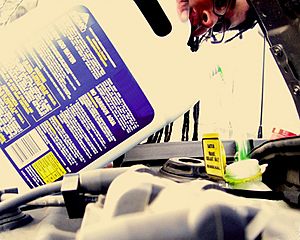Antifreeze facts for kids
Antifreeze is a special liquid that helps stop water from freezing. It's mostly used to protect car engines from damage during cold weather. It also helps keep ice from forming on surfaces like a car's windshield.
Contents
Why is Antifreeze Important?
When water freezes, it expands. In a car's engine, water is used to keep the engine cool. If this water freezes inside the engine's cooling system, it can expand and crack important parts like the engine block or radiator. This can cause very expensive damage to a car.
Antifreeze mixes with the water in the cooling system and lowers its freezing point. This means the mixture will stay liquid even when the temperature drops below zero degrees Celsius (32 degrees Fahrenheit). It also helps the liquid boil at a higher temperature, which is good for keeping the engine from overheating in hot weather.
Antifreeze is also used in other places. For example, it can be added to the water in a car's windscreen washer bottle. This stops the washer fluid from freezing on cold days, so you can still clean your windscreen.
How Does Antifreeze Work?
Antifreeze works by changing the properties of water. Imagine adding salt to water; it makes the water freeze at a lower temperature. Antifreeze does something similar, but it's much more effective for engines.
The main ingredients in most antifreezes are chemicals like ethylene glycol or propylene glycol. When these chemicals mix with water, they interfere with the way water molecules usually line up to form ice crystals. This makes it harder for the water to freeze, so it needs much colder temperatures to turn into ice.
Types of Antifreeze
There are different types of antifreeze, and it's important to use the correct one for a specific vehicle or purpose.
Ethylene Glycol (EG) Antifreeze
This is the most common type of antifreeze used in cars. It's very effective at preventing freezing and overheating. However, ethylene glycol is poisonous if swallowed, so it must be handled with great care and kept away from children and pets. It often has a sweet smell, which can unfortunately attract animals.
Propylene Glycol (PG) Antifreeze
Propylene glycol antifreeze is less toxic than ethylene glycol. It's often used in places where safety is a bigger concern, such as in RVs (recreational vehicles), boats, or in some food processing equipment. While it's safer, it might not be as effective as ethylene glycol in all situations.
Antifreeze Colors
You might notice that antifreeze comes in different colors like green, orange, pink, or blue. These colors usually indicate different types of antifreeze with specific chemical additives. It's very important not to mix different colors or types of antifreeze unless the car manufacturer says it's okay. Mixing them can cause problems in the cooling system.
Using Antifreeze Safely
Because some types of antifreeze are poisonous, it's very important to use them safely:
- Always read the instructions on the antifreeze bottle.
- Never drink antifreeze or let pets drink it.
- Store antifreeze in its original container, out of reach of children and animals.
- If you spill antifreeze, clean it up immediately.
- Dispose of used antifreeze properly. Many auto shops or recycling centers can help with this. Never pour it down the drain or onto the ground.
Images for kids
See also
 In Spanish: Anticongelante para niños
In Spanish: Anticongelante para niños




